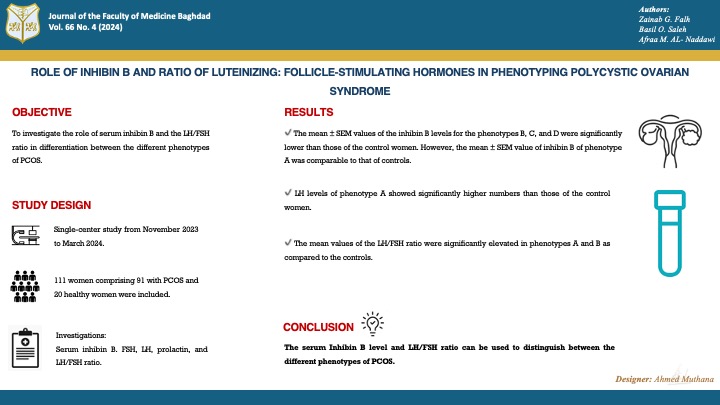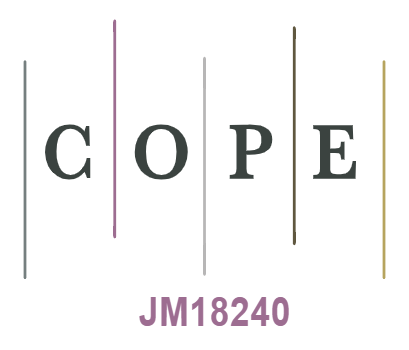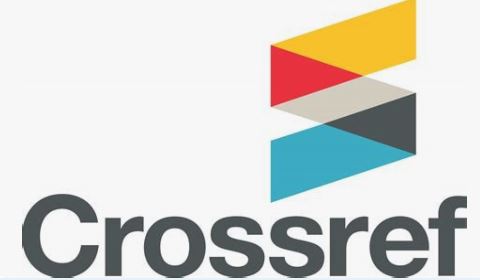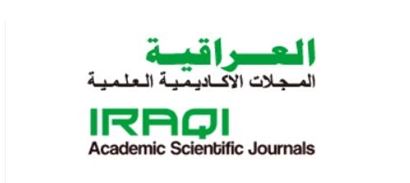دور انهيبين ب والهرمون الملوتن: نسبة الهرمون المنبه للجريب في تمايز الأنماطالظاهرية لمتلازمة المبيض المتعدد الكيسات
DOI:
https://doi.org/10.32007/jfacmedbaghdad.6642418الكلمات المفتاحية:
متلازمة تكيس المبايض، إنهيبين B ، الأنماط الظاهري، نسبة LH/FSHالملخص
الخلاصة: خلفية البحث: تعد متلازمة المبيض المتعدد الكيسات (PCOS) سببًا رئيسيًا لمشاكل الخصوبة وعدم انتظام الدورة الشهرية لدى النساء في سن الإنجاب. تنتج الخلايا الحبيبية في الجريبات أمام الغدة والغربية النامية مادة الإنهيبين ب. الأهداف: تم تصميم هذه الدراسة لمعرفة دور نسبة انهيبين B في الدم والهرمون اللوتيني (LH) / الهرمون المنبه للجريب (FSH) في التمييز بين الأنماط الظاهرية المختلفة لمتلازمة المبيض المتعدد الكيسات. المرضى وطرق العمل /المواد وطرق العمل: تم إجراء هذا البحث المقطعي في قسم الكيمياء الحيوية، كلية الطب، جامعة بغداد في الفترة من نوفمبر 2023 إلى مارس 2024. وشمل 111 امرأة، الفئة العمرية (18-40 سنة)، تم تشخيص 91 من هؤلاء النساء بتكيس المبيض المتعدد. متلازمة تكيس المبايض (PCOS) وفقًا لمعايير إجماع روتردام لعام 2003، وكانت 20 امرأة من النساء الأصحاء على ما يبدو. تم تقسيم النساء المصابات بمتلازمة تكيس المبايض إلى أربع مجموعات من النمط الظاهري (A، B، C، D). شملت التحقيقات قياسات مصل إنهيبين ب باستخدام تقنية مقايسة الامتصاص المناعي المرتبط بالإنزيم (ELISA)، FSH، LH، البرولاكتين باستخدام المقايسة المناعية الآلية Tosoh AIA-2000 وتم حساب نسبة LH/FSH. النتائج: أظهرت النتائج أن النمط الظاهري A هو النمط السائد بين أنماط متلازمة تكيس المبايض، في حين أن النمط الظاهري B هو النمط النادر. كانت القيم المتوسطة (± SEM) لمستويات inhibin B للأنماط الظاهرية B (p = 0.001)، C (p = <0.0001)، D (p = <0.0001) أقل بكثير من تلك الخاصة بالنساء الضابطات. كانت القيمة المتوسطة لمستويات LH للنمط الظاهري A أعلى بكثير من تلك الخاصة بنساء السيطرة (P = 0.03). كانت القيم المتوسطة لنسبة LH / FSH مرتفعة بشكل ملحوظ في الأنماط الظاهرية A (p = 0.001) و B (p = 0.04) بالمقارنة مع الضوابط. الاستنتاج: النمط الظاهري A هو النمط السائد لمتلازمة تكيس المبايض لدى النساء العراقيات. يمكن استخدام مستوى Inhibin B في المصل ونسبة LH/FSH في التمييز بين الأنماط الظاهرية المختلفة لمتلازمة تكيس المبايض.
التنزيلات
المراجع
1. Gupta M, Yadav R, Mahey R, Agrawal A, Upadhyay A, Malhotra N, et al. Correlation of body mass index (BMI), anti-mullerian hormone (AMH), and insulin resistance among different polycystic ovary syndrome (PCOS) phenotypes-a cross-sectional study. Gynecol Endocrinol. 2019;35(11):970-3. https://doi.org/10.1080/09513590.2019.1613640.
2. Shallal MM, Mahmood N, Hussein ZA. Total L-carnitine and insulin resistance in non-obese and obese Iraqi women with polycystic ovary syndrome. J Fac Med Baghdad. 2023;65(1):20-6. https://doi.org/10.32007/jfacmedbagdad.6512040.
3. Hatem A, O Saleh B, M Al-Naddawi A. Association between serum fructose level and insulin resistance in women with polycystic ovary syndrome: The effect of obesity. J Fac Med Baghdad. 2022;64(2):91-5. https://doi.org/10.32007/jfacmedbagdad.6421926.
4. M. Alawad Z. Level of follicular fluid vitamin D and embryo quality in a sample of Iraqi women undergoing IVF. J Fac Med. 2019;60(4):215-21. https://doi.org/10.32007/jfacmedbagdad.604758.
5. Mehra T, Sharma S, Zahra T, Jangir S, Gupta B. Correlation of Body Mass Index with Anthropometric and Biochemical Parameters Among Polycystic Ovary Syndrome Phenotypes. Indian J Clin Biochem. 2023;38(2):231-41. https://doi.org/10.1007/s12291-022-01042-y.
6. Group REPCW. Revised 2003 consensus on diagnostic criteria and long‐term health risks related to polycystic ovary syndrome (PCOS). Hum Reprod. 2004;19(1):41-7. https://doi.org/10.1093/humrep/deh098.
7. Al-Naddawi AM, Rasheed MK, Ghalib MM. Association of Neuregulin-4 levels and body mass index with hyperandrogenism in Polycystic Ovary Syndrome patients. J Fac Med Baghdad. 2024;65(4). https://doi.org/10.32007/jfacmedbagdad.2140.
8. Gürsu T, Eraslan A, Angun B. Comparison of body mass index, anti-müllerian hormone and insulin resistance parameters among different phenotypes of polycystic ovary syndrome. Gynecol Obstet Clin Med. 2022;2(4):164-70.https://doi.org/10.1016/j.gocm.2022.10.002.
9. Ozay AC, Ozay OE, Gulekli B. Comparison of anti-müllerian hormone (aMh) and hormonal assays for Phenotypic Classification of Polycystic ovary Syndrome. Ginekol Pol. 2020;91(11):661-7. https://doi.org/10.5603/GP.a2020.0122.
10. Azziz R, Kintziger K, Li R, Laven J, Morin-Papunen L, Merkin SS, et al. Recommendations for epidemiologic and phenotypic research in polycystic ovary syndrome: an androgen excess and PCOS society resource. Hum Reprod. 2019;34(11):2254-65.https://doi.org/10.1093/humrep/dez185.
11. Hussein RA, Ali IN, Fahad NS. Estimation of Some Biochemical Parameters in Iraqi Infertile Women with Polycystic Ovarian Syndrome . Eur J Mod Med Pract. 2023;3(9):142-8. https://inovatus.es/index.php/ejmmp/article/view/1977.
12. Kalra B, Kumar A, Patel K, Patel A, Khosravi MJ. Development of a second-generation Inhibin B ELISA. J Immunol Methods. 2010;362(1-2):22-31.https://doi.org/10.1016/j.jim.2010.08.002.
13. Hassan HH, Ghazi SM, Nasif AS. Study of a Hormonal Assay in PCOS Patients with Type 2 DM and their Correlation with Inhibin B. Medico-Legal Updat. 2020;20(3). https://doi.org/10.37506/mlu.v20i3.1461.
14. Pratama G, Wiweko B, Asmarinah, Widyahening IS, Andraini T, Bayuaji H, et al. Mechanism of elevated LH/FSH ratio in lean PCOS revisited: a path analysis. Sci Rep. 2024;14(1):8229. https://doi.org/10.1038/s41598-024-58064-0.
15. Jozkowiak M, Piotrowska-Kempisty H, Kobylarek D, Gorska N, Mozdziak P, Kempisty B, et al. Endocrine disrupting chemicals in polycystic ovary syndrome: the relevant role of the theca and granulosa cells in the pathogenesis of the ovarian dysfunction. Cells. 2022;12(1):174. https://doi.org/10.3390/cells12010174.
16. Nisa KU, Tarfeen N, Mir SA, Waza AA, Ahmad MB GB. Molecular mechanisms in the etiology of polycystic ovary syndrome (PCOS): a multifaceted hypothesis towards the disease with potential therapeutics. Indian J Clin Biochem. 2024;39(1):18-36. https://doi.org/10.1007/s12291-023-01130-7.
17. Elsayed AM, Al-Kaabi LS, Al-Abdulla NM, Al-Kuwari MS, Al-Mulla AA, Al-Shamari RS, et al. Clinical phenotypes of PCOS: A cross-sectional study. Reprod Sci. 2023;30(11):3261-72.
https://doi.org/10.1007/s43032-023-01262-4.
18. Rabe-Hesketh S and Everitt BS. A handbook of statistical analyses using stata. Chapman & Hall/CRC, Taylor & Francis group. 2007 Fourth edition.
19. IBM SPSS Statistics 27 Core System User's Guide
20. Carmina E, Lobo RA. Comparing lean and obese PCOS in different PCOS phenotypes: Evidence that the body weight is more important than the Rotterdam phenotype in influencing the metabolic status. Diagnostics. 2022;12(10):2313.https://doi.org/10.3390/diagnostics12102313.
21. Malhotra N, Mahey R, Cheluvaraju R, Rajasekaran K, Patkar D, Prabhakar P, et al. Serum anti-mullerian hormone (AMH) levels among different PCOS phenotypes and its correlation with clinical, endocrine, and metabolic markers of PCOS. Reprod Sci. 2023;30(8):2554-62. https://doi.org/10.1007/s43032-023-01195-y.
22. Si M, Xu W, Qi X, Jiang H, Zhao Y, Li R, et al. Metabolic syndrome rather than other phenotypes in PCOS as a predictive indicator for clinical outcomes in IVF: comprehensive phenotypic assessment across all PCOS classifications. J Clin Med. 2023;12(15):5073. https://doi.org/10.3390/jcm12155073.
23. Obaid RM, Ali SH, Hameed HM. Correlation Between Serum Inhibin and FSH Levels in Women with Different Reproductive Disorders. Int J Res Appl Sci Biotechnol. 2022;9(3):256-61. https://www.ijrasb.com/index.php/ijrasb/article/view/414.
24. Fazil GJ, Sadig HA, Tofig MN, Ali IJ. The levels of inhibin A and inhibin B in PCOS patients. GSC Biol Pharm Sci. 2023;24(1):346-9. https://doi.org/10.30574/gscbps.2023.24.1.0302.
25. Farman MS, Akoul MA, Hamoode RH. Study of some hematological and hormonal changes in patients with (PCOS). Ann Rom Soc Cell Biol. 2021;2288-92. http://annalsofrscb.ro
26. Zhang F, Liu X ling, Rong N, Huang X wen. Clinical value of serum anti-mullerian hormone and inhibin B in prediction of ovarian response in patients with polycystic ovary syndrome. J Huazhong Univ Sci Technol [Medical Sci. 2017; 37:70-3.
https://doi.org/10.1007/s11596-017-1696-x.
27. Fawzy M, Lambert A, Harrison RF, Knight PG, Groome N, Hennelly B, et al. Day 5 inhibin B levels in a treatment cycle are predictive of IVF outcome. Hum Reprod. 2002;17(6):1535-43. https://doi.org/10.1093/humrep/17.6.1535.
28. Murat Ö, ÖZTÜRK HÇ. Anti-Mullerian hormone and HOMA-IR in different phenotypes of polycystic ovary syndrome on insulin resistance. Anatol Curr Med J. 2023;5(4):376-82. https://doi.org/10.38053/acmj.1323489.
29. Sharmin F, Mirza TT, Latif T, Islam FA, Shamsi S, Kabir MA, et al. Hormonal Parameters in Diverse Phenotypes of Polycystic Ovarian Syndrome. Mymensingh Med J MMJ. 2023;32(1):3-9. https://www.researchgate.net/publication/366837382.
30. Jamil AS, Alalaf SK, Al-Tawil NG, Al-Shawaf T. Comparison of clinical and hormonal characteristics among four phenotypes of polycystic ovary syndrome based on the Rotterdam criteria. Arch Gynecol Obstet. 2016; 293:447-56. https://doi.org/10.1007/s00404-015-3889-5.
31. Yilmaz M, Isaoglu U, Delibas IB, Kadanali S. Anthropometric, clinical and laboratory comparison of four phenotypes of polycystic ovary syndrome based on Rotterdam criteria. J Obstet Gynaecol Res. 2011;37(8):1020-6.https://doi.org/10.1111/j.1447-0756.2010.01478.x.
32. Arda Duz S, Tuncay G, Karaer A. Clinical and hormonal characteristics of women with various phenotypes of polycystic ovary syndrome. 2020; ;27(6):1626-30 https://doi.org/10.5455/annalsmedres.2020.02.125.

التنزيلات
منشور
إصدار
القسم
الرخصة
الحقوق الفكرية (c) 2024 Zainab G. Falh, Basil O. Saleh, Afraa M. Al Naddawi, Ghada Mohammed

هذا العمل مرخص بموجب Creative Commons Attribution 4.0 International License.










 Creative Commons Attribution 4.0 International license..
Creative Commons Attribution 4.0 International license..


